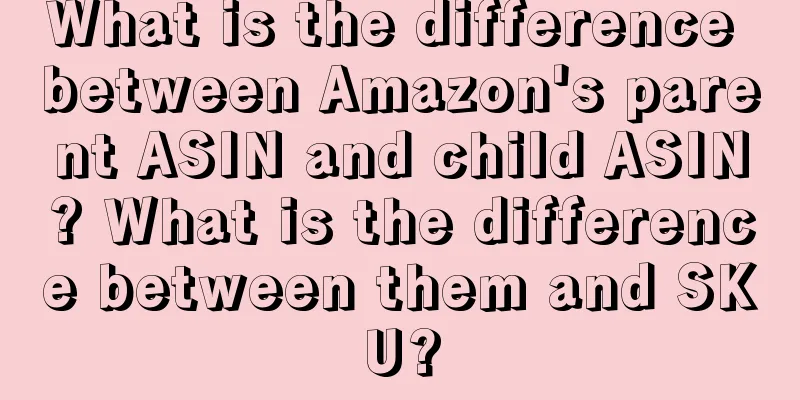What is the difference between Amazon's parent ASIN and child ASIN? What is the difference between them and SKU?

|
On the Amazon platform, we often come across two terms: parent ASIN and child ASIN. They are unique identifiers used to describe products on Amazon, but they differ in function and application. So, what is the difference between Amazon parent ASIN and child ASIN? 1. What is the difference between Amazon's parent ASIN and child ASIN? Parent ASIN refers to the main listing page of a product, usually created by the seller. This parent ASIN represents the overall information of a product, including different variations and options. Sellers can combine multiple variations of the same product under one parent ASIN for better management and display. Sub-ASIN refers to the specific variants or options under the parent ASIN. A product may have multiple sub-ASINs, each of which corresponds to different product variants such as color, size, style, etc. Sub-ASINs have independent inventory, evaluation and sales data, and consumers can choose the appropriate sub-ASIN to purchase according to their needs. On Amazon, parent ASINs and child ASINs are connected to each other through an association relationship. The parent ASIN provides an overview that enables consumers to quickly browse and compare different variations, while the child ASIN provides more specific product information and purchasing options. 2. What is the difference with SKU? In addition to parent ASIN and child ASIN, there is another term we often hear: SKU. SKU stands for "Stock Keeping Unit" and refers to the unique identifier that sellers assign to products in order to better manage inventory. Unlike ASIN, each SKU is unique and is usually created and assigned by the seller according to their own management needs. SKU can be any combination of letters, numbers or combinations, and is used to track products in sales and inventory management. Compared with ASIN, SKU focuses more on inventory management and internal operations. By using SKU, sellers can better track and manage inventory, including replenishment, shipment, and inventory reporting. ASIN is mainly used for product sales and display on the Amazon platform. It should be noted that the parent ASIN may correspond to one SKU or multiple SKUs. This depends on the seller's methods and strategies for managing and organizing products. Therefore, when using ASIN and SKU, sellers need to make reasonable allocations and applications based on their own circumstances and needs. Through this article, we learned that there are two identifiers on the Amazon platform: parent ASIN and child ASIN. Parent ASIN represents the overall information of a product, while child ASIN represents different variations of the same product. Unlike ASIN, SKU is a unique identifier assigned by sellers to better manage inventory. Recommended reading: How does Amazon view its own ad placements? How to choose ad placements? How to transfer the balance in Amazon account? How to check the withdrawal record? Will a newly registered eBay business account be frozen? What is the reason for freezing? |
<<: Is it a big investment to set up an independent website? What aspects require money?
>>: Pinduoduo Temu releases Canadian glazed ceramic and glassware compliance requirements
Recommend
Does Shopee not allow mainland China to buy? Can I buy it in China?
If you want to buy something on the Shopee platfor...
How to chat with customers on Shopee? What should I pay attention to when setting up automatic replies?
Merchants who open stores on Shopee need to deal w...
Brand communication is more about telling stories than reasoning
Brands need a storyteller, and brand communication...
How long does it usually take for Amazon to withdraw cash? What are the withdrawal rules?
Now the prospect of cross-border e-commerce is rea...
How long does it take for RMB to be credited to my account? What should I do if it takes a long time for my account to be credited to my account?
In the context of deepening globalization, RMB set...
How long can Wahaha continue to reap the benefits of traffic?
Wahaha, which became popular in March, has reaped ...
How can Xiaohongshu private domain merchants efficiently acquire customers? Involving industries such as decoration, wedding photography, jewelry, and confinement centers
Xiaohongshu is a gathering place for attracting cu...
Why has offline store design become a battleground for brand marketing?
Have you taken a citywalk today? As this simple an...
Can a frozen Shopee Thailand store be unblocked? What is the reason?
Previously, many sellers of Shopee Thailand stores...
Can I open a Shopee account with a studio's business license? How can I register?
We all know that if you want to open a store and s...
Does Shopee provide traffic support for new stores? How can new stores increase traffic?
When opening a new store, the speed of placing an ...
Mengniu vs. Yili, is the value of top official sponsors not as good as that of ordinary sponsors?
The marketing war between Yili and Mengniu in the ...
Can I only log in to Amazon with one computer? Can I only log in with one IP?
To open a store on Amazon, you need a computer. An...
Can individual business owners do business on Amazon? What are the requirements?
Amazon is a relatively old cross-border e-commerce...
How to reduce Amazon return rate? What are the methods?
In online sales, handling returns is an important ...









